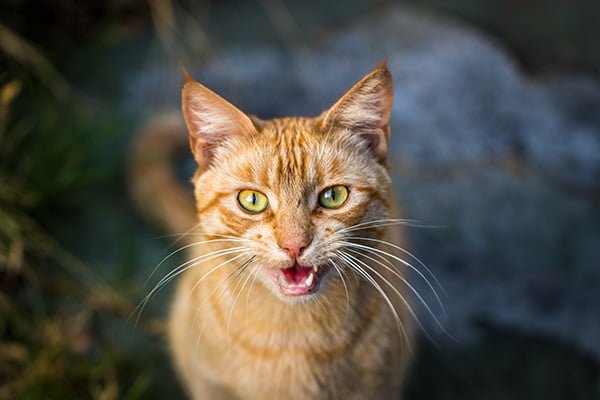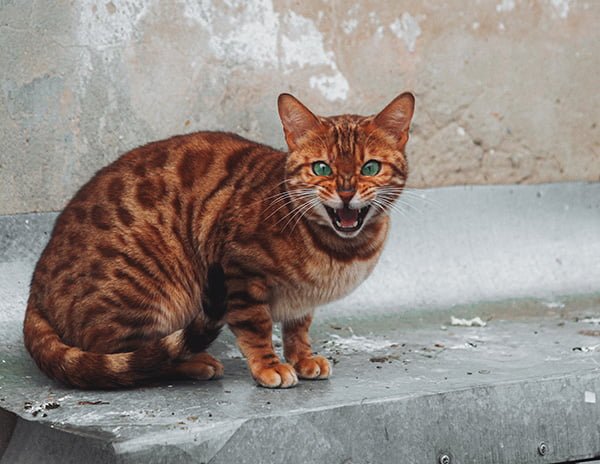Welcome to the purr-fect world of cats, and the fascinating cat sounds cat emits. These furry felines are not only adorable and cuddly, but they are also known for their unique personalities and behaviors. One of the intriguing things about cats is the wide range of sounds they make. From the soft purring of contentment to the loud yowling of distress, cats use vocalization to communicate their needs and emotions. In fact, cats can make up to 21 different vocalizations.
As cat owners, understanding the cat sounds that your cat makes is an essential part of feline care as it can help you differentiate a happy cat from a distressed one. If you are curious about what your cat says when they make sounds, then let's explore the enchanting world of cat sounds and discover how these charming vocalizations can enhance our lives and the lives of our beloved cats.
Most Common Cat Sounds
Cat Meow
Cat meowing is just one of the many ways cats communicate with their humans. Contrary to popular belief, cats don't communicate with each other by meowing - they reserve this vocalization specifically for us. So, what does it mean when your furry friend meows at you? A cat's meow could be a request for attention, food, or simply a greeting. However, excessive meowing could also indicate anxiety, stress, or an underlying medical condition.
By paying attention to the duration, tone, pitch, and frequency of cat meows and body language, you can better understand what the cat is trying to tell you. A high-pitched meow could indicate excitement or hunger, while a low-pitched growl could signify fear or aggression. When cats meow repeatedly, it can be a sign of stress.
Older cats tend to meow more than younger cats due to failing senses, increased anxiety as they age, and declining health reasons.They may meow more frequently to get attention from their owners, especially if they feel lonely or bored.
Cat Purr
While we often associate cats purring with a content and happy cat, there's actually much more to this soothing sound. Did you know that cats can purr when they're in pain or distress, as well as when they're happy? By decoding the nuances of your cat's purr, you can gain insight into its emotional state and overall health. For example, a low-pitched and continuous purr may indicate pain or discomfort, while a high-pitched and intermittent purr may signify happiness and relaxation. Additionally, recent studies suggest that a cat's purr may have therapeutic benefits for both cats and humans by reducing stress and promoting healing.
The "worry-purr" is rare, but some cats purr when it's emotional. Like how we might nervously whistle or hum to calm ourselves down, cats can sometimes purr when anxious or distressed. However, the key to understanding this purring type is your cat's body language. If your furry friend's ears are back and their body appears tense, the purring may indicate concern or unease. Be sure to pay attention to your cat's subtle cues and body language so you can better discern their emotional state and provide them with the care and attention they need.

Source: Unsplash
Chirping
Cat chirping is a sound that seems like a cross between a meow and a bird's tweet. This unique vocalization is a sign of excitement and anticipation, often observed when cats watch birds or prey through a window. You can better understand your cat's instincts and motivations by decoding your cat's chirping. For example, a quick and sharp chirp may indicate an eagerness to catch prey, while a slower and softer chirp may signify curiosity or playfulness. Chirping is just one of the many ways that cats communicate with us and each other, and by learning to recognize and respond to these sounds, we can deepen our bond with these beloved pets.
Cat Hiss
Hissing is a vocalization that cats use to communicate their fear, aggression, or discomfort. It's a warning sign that they're feeling threatened or defensive, and it's their way of telling other animals or humans to back off. By understanding the nuances of your cat's hissing, you can better discern their emotional state and take the necessary steps to keep them safe and calm. For example, a hiss accompanied by a flattened body and dilated pupils may indicate fear or anxiety, while hissing with an arched back and puffed-up fur may signify aggression or territorial behavior.
It's important to remember that hissing is a natural and instinctive behavior for cats, and we shouldn't punish or scold them for it. Instead, we should learn to recognize their cues and respond appropriately to their needs.
Cat Chattering
Chattering is characterized by rapid and rhythmic teeth chattering, often accompanied by a tail twitching and dilated pupils. It is a unique vocalization that occurs when cats are excited or aroused by the sight of prey, such as birds or squirrels. It's a natural instinct that dates back to their wild ancestors, who used this technique to communicate with fellow hunters.
By decoding your cat's chattering, you can better understand its hunting instincts and motivations. For example, a rapid and rhythmic chattering may indicate extreme excitement and eagerness to catch prey, while a slower and more deliberate chattering may signify a more relaxed and playful mood. Chattering is just one of the many ways that cats communicate with us and each other, and by learning to recognize and respond to these sounds, we can deepen our bond with these beloved pets.
Yowl
If you've ever heard your cat yowl, you know it's a sound that commands attention and often leaves you wondering what's wrong. The cat yowl is a long, drawn-out, and loud sound that can indicate a range of emotions and motivations. It's often heard when cats are in heat or searching for a mate, but it can also be a sign of fear, frustration, or pain. Understanding the context of your cat's yowl is essential to decoding their message and responding appropriately.
If your cat is yowling due to mating behaviors, you may notice other accompanying behaviors, such as rubbing against furniture or vocalizing more frequently than usual. On the other hand, if your cat is yowling due to fear or pain, you may notice other physical signs such as flattened ears, dilated pupils, or a hunched posture. It's important to address the underlying cause of your cat's yowling behavior, whether by providing appropriate outlets for their mating behaviors, addressing their fear or anxiety, or seeking medical attention for a potential health issue.
Cat Caterwaul
The cat caterwaul is a loud and guttural sound that is often associated with mating behaviors. It's a call for attention from male cats, who use this vocalization to attract potential mates during the breeding season. However, female cats can also caterwaul, especially when they are in heat or feel threatened.
Cat caterwauling is characterized by a long and sustained sound ranging from a low growl to a high-pitched scream. It's often accompanied by physical behaviors such as pacing, rubbing against objects, or arching their backs. While cat caterwauling can be a natural behavior, it can also be a sign of underlying stress or anxiety. For example, if your cat feels threatened by another cat in the neighborhood, it may caterwaul to communicate its discomfort and assert its territory.
If you notice your cat caterwauling frequently or in unusual contexts, it's important to address the underlying cause. Providing appropriate outlets for your cat's mating behaviors, addressing any potential sources of stress, or seeking medical attention if there is a potential health issue are all important steps to take.

Source: Pexels
Cat Snarls And Growls
Cat snarls and growls are powerful expressions of a cat's emotions and can be startling. These vocalizations are often accompanied by physical displays of aggression, such as flattened ears, arched backs, and raised fur. Despite their intimidating nature, these sounds are important in feline communication, and cats use them to assert their dominance and communicate their boundaries to other animals. Various situations can trigger these vocalizations, such as territorial disputes, perceived threats, or pain. It's important to pay attention to the cat's body language, such as arched backs, puffed hair, twitchy tails, flattened ears, and bared fangs, as these can provide valuable clues to the cat's emotional state.
If you notice your cat snarling, growling, and other cat sounds, it's important to take a step back and assess the situation. Your cat may feel threatened or uncomfortable, so giving them their space and avoiding aggressive behavior is important. It's also important to note that not all cat snarls and growls are signs of aggression. Sometimes, cats may use these vocalizations during play or to communicate excitement.
Cat Scream
You'll never forget a cat scream if you have heard it. It's a high-pitched, piercing noise that many situations can trigger. A scream from a cat is usually a sign of extreme distress or pain, and it's important to take it seriously. When a cat screams, it's often accompanied by physical signs of fear or discomfort, such as dilated pupils, flattened ears, and a hunched body posture. This vocalization is usually reserved for extreme stress, such as when a cat is injured, frightened, or feeling threatened.
If you hear your cat scream, it's important to approach them with caution and seek immediate medical attention. A cat in distress may be unpredictable and lash out in fear, so it's best to handle them with care and let a veterinarian assess the situation. It's important to remember that not all cat screams are signs of physical pain. Sometimes, cats may vocalize this way when they feel overwhelmed or scared, such as during a trip to the vet or encountering a new animal or person.
Cat Howls
Cat howling is a haunting, prolonged sound that can make pet owners uneasy. This deep, mournful noise can occur in response to various situations, but it's important to notice when it happens. When a cat howls, it's usually a sign of deep emotional distress or pain. The cat may display signs of anxiety and discomfort, such as pacing, restlessness, or aggression. This vocalization is usually reserved for intense emotional pain, such as the loss of a companion, the onset of a medical condition, or a traumatic experience.
When your cat starts howling, handling the situation with care and seeking prompt medical attention is crucial. Your cat may be in distress and react unpredictably, possibly causing harm to themselves or others. A professional veterinarian should evaluate your cat's behavior to determine the underlying cause. However, not all howls from cats are indicative of physical pain. Sometimes, cats use this vocalization to express loneliness, anxiety, or fear. For instance, if the cat is left alone for an extended period or separated from their human or feline companions.
